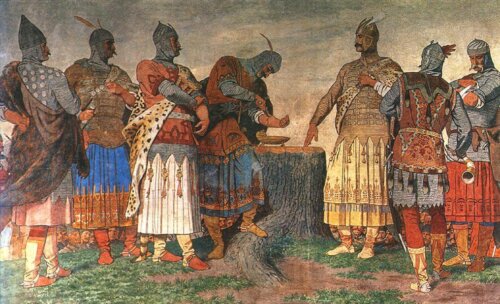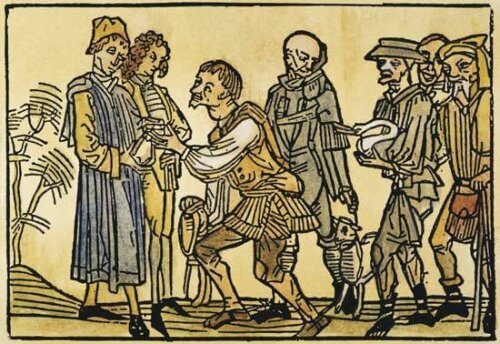1000 A.D. the Year of the Apocalypse

It’s difficult to explain the feeling of having an Apocalypse at your doorstep, which occurred in the year 1000 A.D. in Europe. Obviously, the prediction was false.
Many of Paul’s Letters or the Apocalypse, supposedly John’s, in the New Testament, convey the feeling of the near culmination of the times. After the Ascension of Christ, an early coming would surely begin the Final Judgment. What’s certain is that the biblical times of God aren’t those of men, and certainly in our eyes the end of all things wasn’t so imminent.
Throughout history, there are many who, supported by these texts, have assured a near Apocalypse, but perhaps none with as much prediction as those who announced it around the year 1000. Perhaps its popularity was due to the superstition of the round number. Or maybe to the perception of an increase of evils and dangers or perhaps to the political and religious change. In addition, it could be because these things were all happening at the same time.
Christianity, ravaged by its enemies
One of the proofs of the end of the world would be the extermination and persecution of God’s flock. There were groups that committed these crimes at the end of the 1oth century. Of all the pagan peoples that still plagued Christendom, the ones that could most evoke the Apocalypse were, without a doubt, the invincible Magyar horsemen in Hungary. No less terrifying were the bloodthirsty Vikings who ravaged England, neglecting the Peace of God.

Mohammedan apocalypse?
While some areas of Europe were vulnerable to these two pagan peoples, there was an omnipresent evil that posed the greatest threat to the Church. The Muslim Egyptian Fatimid caliph ordered the destruction of hundreds of Coptic temples in his territory, where many Christians had lived. Then, there were the Muslim Bedouins who plundered churches in Palestine and attacked pilgrims on their way to Jerusalem. With the Holy Land dominated by the enemies of the cross, it was hard to find better proof of the coming Apocalypse.
Above all else, Muslims occupied the kingdoms of southern Hispania that were victorious against the Christian kings. In fact, Almanzor was a famous Muslin in the Umayyad caliphate. In 985, Almanzor defeated Charlemagne’s successors in Barcelona. He sacked Santiago de Compostela in 997, and the protection of the Apostle didn’t prevent the tragedy. Many more raids followed on the part of “The Victorious One”. So who would he attack in the year 1000?
“But about that day or hour no one knows, not even the angels in heaven, nor the Son, but only the Father.”
-Matthew 24:36-
The Apocalypse and propaganda
Many echoed these suspicions linking wars to famines or epidemics. The most famous text would be the Libellus of Adso de Montier-en-Der, who warned of the Carolingian decadence and the ensuing End of Times.
Other opportunists, such as the Count of Sens, decided to blame the bad harvests on the approaching Apocalypse, to avoid a revolt. The prophets were quick to warn the people.
Among all the proposals, the most popular was Millenarianism. It proposed that what was to come wasn’t the End, but a Coming of Christ to rule the world for a thousand years. Condemned as heresy, it became a valve for certain popular frustrations. Undoubtedly, a monarch like the Master would bring about a profound spiritual and social renewal that would lead to greater equality.
Of all the changes that the people of the late first millennium anticipated, at least one did take place. This was when the so-called feudal revolution occurred.
Hugh Capet, Count of Paris who took the throne of France, is a paradigmatic example. Throughout Christendom, there was a succession of feudal lords who accumulated royal powers and de facto political independence.
The Church, unwilling to surrender its power to the system of royal values, organized the assemblies of peace and truce of God, code names in Catalonia. The full Middle Ages were beginning.

Life went on
The dreaded Scandinavians converted to Roman Christianity precisely in the year 1000. This was shortly after the father of Stephen I of Hungary had united his people with Rome. Only two years later, Almanzor died. Consequently, this left a caliphate in crisis that caused its break up and stopped its progressive northern conquest.
The massive misinterpretation of historical facts, both by cultivated and laypeople, shouldn’t surprise us. Even today we fall into the same methodical error: to interpret historical facts as a progressive succession towards a point. At the same time, history doesn’t present a gradual evolution towards good or evil, towards the end or progress. Also, it’s not a projection towards freedom or tyranny, towards equality or any other value.
* The astonishing apocalyptic pictorial and literary works initiated by Beato de Liébana remain a legacy.
It’s difficult to explain the feeling of having an Apocalypse at your doorstep, which occurred in the year 1000 A.D. in Europe. Obviously, the prediction was false.
Many of Paul’s Letters or the Apocalypse, supposedly John’s, in the New Testament, convey the feeling of the near culmination of the times. After the Ascension of Christ, an early coming would surely begin the Final Judgment. What’s certain is that the biblical times of God aren’t those of men, and certainly in our eyes the end of all things wasn’t so imminent.
Throughout history, there are many who, supported by these texts, have assured a near Apocalypse, but perhaps none with as much prediction as those who announced it around the year 1000. Perhaps its popularity was due to the superstition of the round number. Or maybe to the perception of an increase of evils and dangers or perhaps to the political and religious change. In addition, it could be because these things were all happening at the same time.
Christianity, ravaged by its enemies
One of the proofs of the end of the world would be the extermination and persecution of God’s flock. There were groups that committed these crimes at the end of the 1oth century. Of all the pagan peoples that still plagued Christendom, the ones that could most evoke the Apocalypse were, without a doubt, the invincible Magyar horsemen in Hungary. No less terrifying were the bloodthirsty Vikings who ravaged England, neglecting the Peace of God.

Mohammedan apocalypse?
While some areas of Europe were vulnerable to these two pagan peoples, there was an omnipresent evil that posed the greatest threat to the Church. The Muslim Egyptian Fatimid caliph ordered the destruction of hundreds of Coptic temples in his territory, where many Christians had lived. Then, there were the Muslim Bedouins who plundered churches in Palestine and attacked pilgrims on their way to Jerusalem. With the Holy Land dominated by the enemies of the cross, it was hard to find better proof of the coming Apocalypse.
Above all else, Muslims occupied the kingdoms of southern Hispania that were victorious against the Christian kings. In fact, Almanzor was a famous Muslin in the Umayyad caliphate. In 985, Almanzor defeated Charlemagne’s successors in Barcelona. He sacked Santiago de Compostela in 997, and the protection of the Apostle didn’t prevent the tragedy. Many more raids followed on the part of “The Victorious One”. So who would he attack in the year 1000?
“But about that day or hour no one knows, not even the angels in heaven, nor the Son, but only the Father.”
-Matthew 24:36-
The Apocalypse and propaganda
Many echoed these suspicions linking wars to famines or epidemics. The most famous text would be the Libellus of Adso de Montier-en-Der, who warned of the Carolingian decadence and the ensuing End of Times.
Other opportunists, such as the Count of Sens, decided to blame the bad harvests on the approaching Apocalypse, to avoid a revolt. The prophets were quick to warn the people.
Among all the proposals, the most popular was Millenarianism. It proposed that what was to come wasn’t the End, but a Coming of Christ to rule the world for a thousand years. Condemned as heresy, it became a valve for certain popular frustrations. Undoubtedly, a monarch like the Master would bring about a profound spiritual and social renewal that would lead to greater equality.
Of all the changes that the people of the late first millennium anticipated, at least one did take place. This was when the so-called feudal revolution occurred.
Hugh Capet, Count of Paris who took the throne of France, is a paradigmatic example. Throughout Christendom, there was a succession of feudal lords who accumulated royal powers and de facto political independence.
The Church, unwilling to surrender its power to the system of royal values, organized the assemblies of peace and truce of God, code names in Catalonia. The full Middle Ages were beginning.

Life went on
The dreaded Scandinavians converted to Roman Christianity precisely in the year 1000. This was shortly after the father of Stephen I of Hungary had united his people with Rome. Only two years later, Almanzor died. Consequently, this left a caliphate in crisis that caused its break up and stopped its progressive northern conquest.
The massive misinterpretation of historical facts, both by cultivated and laypeople, shouldn’t surprise us. Even today we fall into the same methodical error: to interpret historical facts as a progressive succession towards a point. At the same time, history doesn’t present a gradual evolution towards good or evil, towards the end or progress. Also, it’s not a projection towards freedom or tyranny, towards equality or any other value.
* The astonishing apocalyptic pictorial and literary works initiated by Beato de Liébana remain a legacy.
All cited sources were thoroughly reviewed by our team to ensure their quality, reliability, currency, and validity. The bibliography of this article was considered reliable and of academic or scientific accuracy.
- Duby, Georges (2000) El año Mil. Una interpretación diferente del milenarismo, Gedisa.
- Focillon, Henry (1998) El año Mil, Alianza.
This text is provided for informational purposes only and does not replace consultation with a professional. If in doubt, consult your specialist.







